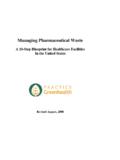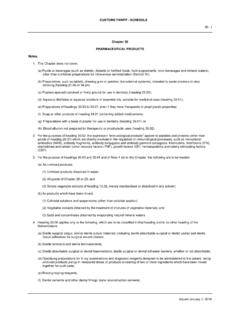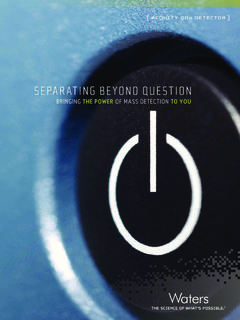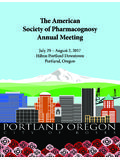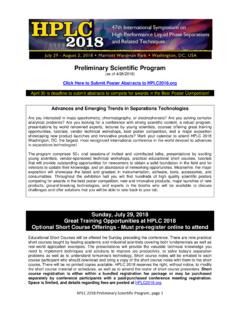Transcription of Managing Pharmaceutical Waste - hercenter.org
1 Managing Pharmaceutical Waste A 10-Step Blueprint for Healthcare Facilities In the United States Revised August, 2008. Acknowledgements The original Blueprint, published on April 15th, 2006, was written primarily by Eydie Pines, Hospitals for a Healthy Environment and Charlotte Smith, PharmEcology Associates, LLC. The EPA, Office of Solid Waste and Emergency Response, Innovation Initiative, provided funding for the original project and Mary Dever and Peggy Bagnoli, EPA Region I, were responsible for it. Funding for this revision was provided by the Healthcare Environmental Resource Center (HERC), a compliance assistance website operated by the National Center for Manufacturing Sciences. Charlotte Smith, President, PharmEcology Associates, LLC is the primary author. The following people offered their time and expertise in reviewing the document: Charles Allen, TN Dept.
2 Of Environment and Conservation Michael Burke, North Memorial Health Care Janet Bowen, EPA, Region 1. Steven Kubo, California Dept. of Public Health Lisa Lauer, EPA, Office of Solid Waste Jack McGurk, Systems Improvement Initiators Special thanks to Catherine Zimmer, Education and Healthcare Specialist, Minnesota Technical Assistance Program, for the Pharmaceutical Waste minimization case studies presented in Appendix C. Special thanks also to Hennepin County Medical Center, Minneapolis, MN and Falls Memorial Hospital, International Falls, MN for their participation in the Pharmaceutical Waste minimization studies. The following people were especially helpful in reviewing the original Blueprint: Fawzi Awad, Saint Paul - Ramsey County Department of Public Health Laura Brannen, Hospitals for a Healthy Environment Michael Burke, North Memorial Medical Center Gail Cooper, EPA, Office of Solid Waste Janet Bowen, EPA Region I.
3 Jerry Fink, North Memorial Medical Center John Gorman, EPA Region II. Kristin Fitzgerald, EPA, Office of Solid Waste Sara Johnson, New Hampshire Department of Environmental Services Lisa Lauer, EPA, Office of Solid Waste Steven Lucio, Novation Meg McCarthy, EPA, Office of Solid Waste Patricia Mercer, EPA, Office of Solid Waste James Michael, EPA, Office of Solid Waste Virginia Thompson, USEPA Region III. David Stitzhal, Pharmaceuticals from Households: A Return Mechanism Alan Woodard, New York State Department of Environmental Conservation 2. Catherine Zimmer, Minnesota Technical Assistance Program Special thanks to staff at Dartmouth-Hitchcock Medical Center for their participation in the project, particularly Lindsey Waterhouse. 3. Table of Contents Acknowledgements .. 2. 8. Navigating the Blueprint.
4 9. Applying the Precautionary 11. Step One: Getting Started .. 12. Step Two: Understanding the Regulations .. 13. 1. Defining Hazardous Waste Categories ..14. a. P- Listed Wastes (40 CFR Part (e)) .. 14. i. Two Necessary Conditions (40 CFR Part ) .. 15. ii. Empty Containers of P-Listed Wastes (40 CFR Part (b)(3)) .. 16. iii. Dilute Concentrations of P-Listed Waste .. 17. Epinephrine Syringe Interpretation Extended to Other P and U-Listed Drugs 17. v. Epinephrine Salts Interpretation .. 18. vi. Nitroglycerin 18. b. U-Listed Wastes (40 CFR Part (f)) .. 19. i. Two Necessary Conditions .. 19. ii. Empty Containers of U-Listed Wastes (40 CFR Part (b)(1)) .. 20. c. Characteristic Hazardous Waste (40 CFR Parts ).. 20. i. Ignitability: D001 (40 CFR ) .. 20. Table 3: Pharmaceuticals with Ignitability Characteristics.
5 23. ii. Corrosivity: D002 (40 CFR Part ).. 23. iii. Reactivity: D003 (40 CFR Part ) .. 24. iv. Toxicity: Multiple D Codes (40 CFR Part ) .. 24. v. Empty Containers of Characteristic Wastes (40 CFR ) .. 24. 2. Grappling with Hazardous Waste a. Contaminated Personal Protective Equipment and Spill Materials .. 25. i. Listed Waste .. 25. ii. Characteristic Waste .. 25. b. Regulated Medical Waste (Biohazardous) .. 26. c. 26. d. Controlled Substances (21 CFR Parts 1300 to 1399) .. 27. 3. Distinguishing Between Trace and Hazardous Chemotherapy Waste ..28. a. 28. b. Trace Chemotherapy 29. c. Hazardous Chemotherapy 29. i. Combination Hazardous Chemotherapy and Regulated Medical Wastes .. 30. 4. ii. Spill and Decontamination Materials .. 30. 4. Understanding Hazardous Waste Management ..32.
6 A. Generator 32. b. Drain Disposal (4 40 CFR (p)) .. 34. c. Incineration .. 34. 5. The Impact of Including Pharmaceuticals in the Universal Waste Rule ..36. Step 3: Considering Best Management Practices for Non-Regulated Pharmaceutical Wastes .. 38. 1. Formulations With a Listed Active Ingredient That is Not the Sole Active Ingredient ..39. 2. All Chemotherapeutic 3. Drugs Meeting NIOSH Hazardous Drug 4. Drugs Listed in Appendix VI of OSHA Technical Manual ..41. 5. Carcinogenic Drugs ..41. 6. Drugs with LD50s Less Than or Equal to 50 mg/kg ..42. 7. Combination Vitamin/Mineral Preparations with Heavy Metals ..42. 8. Endocrine Disruptors ..42. 9. All Other a. Incinerate .. 43. b. Eliminate Drain 44. c. Avoid Landfilling .. 44. Step 4: Performing a Drug Inventory Review .. 46. 1. Gathering Drug Specific a.
7 Compounded Items and Re-formulations .. 47. 2. Making RCRA Hazardous Waste Determinations ..48. a. 48. b. Best Management Practices .. 49. 1. Documenting Your 2. Keeping the Review 3. Employing Alternative Step 5: Minimizing Pharmaceutical 51. 1. Considering Lifecycle Impacts in the Purchasing Process ..51. 2. Maximizing the Use of Opened Chemotherapy Vials ..51. 3. Implementing a Samples 4. Labeling Drugs for Home 5. Priming and Flushing IV Lines with Saline Solution ..53. 6. Examining the Size of Containers Relative to 7. Replacing Prepackaged Unit Dose Liquids with Patient-Specific Oral 8. Controlled 9. Delivering Chemotherapy Drugs ..54. 10. Monitoring Dating on Emergency Syringes ..54. 11. Reviewing Inventory Controls to Minimize Outdates ..55. 5. Step 6: Assessing Current Practices.
8 56. 1. Performing Department 2. Conducting a Frequency Analysis ..57. 3. Confirming Your Generator Step 7: Taking On the Communication/Labeling 59. 1. Automating the Labeling Process ..59. a. Incorporating Disposition Data in Dispensing Software .. 59. b. Inserting Disposition Data on Barcodes .. 60. 2. Manually Labeling in the Pharmacy ..60. 3. Providing Guidance on the Nursing Units ..60. 4. Selecting a Message for the Label ..60. Step 8: Considering the Management Options .. 62. 1. Models 1, 2, and 3: Segregating at the Point of Generation ..62. 2. Model 4: Centralized Segregation ..64. 3. Model 5: Managing All Drug Waste as Hazardous ..65. Step 9: Getting Ready for Implementation .. 66. 1. Locating Your Satellite Accumulation a. Corrosive 67. b. Non-hazardous Pharmaceutical 67.
9 2. Evaluating Your Hazardous Waste Storage Accumulation Area ..67. 3. Selecting the Right Vendor(s)..68. a. Reverse Distributors Are Not Waste Management Services .. 69. 4. Conducting a Pilot 5. Putting It All Together: Pharmaceutical Waste Management Policies and Procedures ..71. 6. Preparing for Spills ..72. Step 10: Launching the 74. 1. Educating and Training Staff ..74. 2. Staging the Roll-Out ..74. 3. Filling out the a. Hazardous Waste Manifest (40 CFR Parts ).. 75. b. Land Disposal Restrictions Form (40 CFR Part ).. 76. 4. Tracking, Measuring and Recording Next Steps .. 78. 1. Provide Additional Pharmaceutical Waste Management Assistance to Hospitals ..78. 2. RCRA Hazardous Waste Regulations: Clarify, Reconsider and Expand ..78. 3. Eliminate Drain 4. Making the Hazardous Waste Determination: A Communications Challenge.
10 79. 5. Broaden National Knowledge Base of Pharmaceutical Waste Generation ..80. 6. Waste 6. a. Routinely Wasted Drugs .. 80. b. 80. Summary .. 81. Appendix A: Tools and 82. Appendix B: Sample Toxicity Characteristic Calculations .. 87. Appendix C: Pharmaceutical Waste Minimization: Two Case Studies .. 91. 7. Introduction The discovery of a variety of pharmaceuticals in surface, ground, and drinking waters around the country is raising concerns about the potentially adverse environmental consequences of these contaminants. Minute concentrations of chemicals known as endocrine disruptors, some of which are pharmaceuticals, are having detrimental effects on aquatic species and possibly on human health and development. 1 The consistent increase in the use of potent pharmaceuticals, driven by both drug development and our aging population, is creating a corresponding increase in the amount of Pharmaceutical Waste generated.
